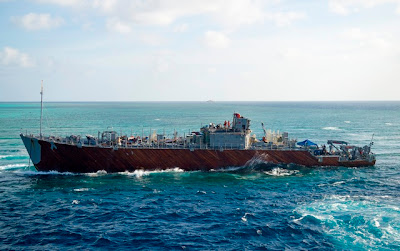US Navy salvage operations in Philippines’ Tubbataha Reef continues
 |
|
SULU SEA, Philippines (Mar. 8, 2013) —
The U.S. Navy contracted crane vessel M/V Jascon 25 removes a segment of the
superstructure from the mine countermeasure ship Ex-Guardian (MCM 5), which ran
aground on the Tubbataha Reef Jan. 17. The U.S. Navy and contracted salvage
teams continue damage assessments and the removal of equipment and parts to
prepare the grounded ship to be safely dismantled and removed from Tubbataha
Reef. The U.S. Navy continues to work in close cooperation with the Philippine
authorities to safely dismantle Guardian from the reef while minimizing
environmental effects. Photo by U.S. Navy Mass Communication Specialist 3rd
Class Kelby Sanders/Released)
|
SAIPAN, Northern Mariana Islands — EFFORTS at dismantling a 224-foot U.S. Navy minesweeper
from a UNESCO World Heritage Site in the Philippines continue.
LT David A. Levy, Deputy Public Affairs Officer, Commander, U.S. Seventh Fleet told Variety Friday [March 8], “The USS Guardian salvage efforts are continuing as the weather and sea states have been cooperative.”
The USS Guardian ran aground on Tubbataha Reef last Jan.
17 while transiting the Sulu Sea.
With the failure of the first salvage ship to anchor, the U.S. Navy salvage plan
required the use of a second crane ship — Jascon 25 — with a higher lifting
capacity than Smit Borneo, the first crane ship.
The salvage plan is making progress.
Levy said, “U.S. Navy contracted vessel M/V Jascon 25 and
Smit Borneo salvors, along with sailors from Mobile Diving and Salvage Unit ONE
removed the upper half of the superstructure off the mine countermeasure ship
Ex-Guardian on 2 March.”
He said that salvage experts continue to refine the
salvage plan “which is a complex operation.”
“The salvage plan emphasizes safety of personnel and
protection of the Tubbataha Reef ecosystem,” said Levy.
Earlier, it was reported that the salvage operations will
be anticipated over by March 23.
For Levy, “The timeline for completion will depend on
several factors, including the condition of the ship, weather conditions, and
sea states.”
He also said that assessments of reef damage will be
conducted when the ship has been removed.
The U.S. Navy, he said, is dedicated to responsibly
salvage Guardian “in a safe manner while minimizing environmental damage.”
Moreover, the salvage operations initially cost $24.89
million.
The Navy awarded SMIT Salvage out of Singapore a
$24,889,904 contract to provide support for emergency response and recovery
operations for the USS Guardian.
Final costs relating to the salvage operations have yet to
be determined.
The U.S. Navy continues to work with the Philippine
government.



Comments